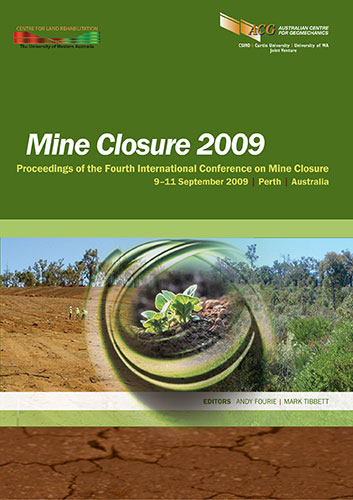Strangers in a foreign land — developing cultural closure criteria for mines in Australia’s Northern Territory

|
Authors: Smith, HD |
DOI https://doi.org/10.36487/ACG_repo/908_Smith
Cite As:
Smith, HD 2009, 'Strangers in a foreign land — developing cultural closure criteria for mines in Australia’s Northern Territory', in AB Fourie & M Tibbett (eds), Mine Closure 2009: Proceedings of the Fourth International Conference on Mine Closure, Australian Centre for Geomechanics, Perth, pp. 3-11, https://doi.org/10.36487/ACG_repo/908_Smith
Abstract:
The Northern Land Council is a statutory body created under the Aboriginal Land Rights Act (1976) to protect the rights and interests of traditional Aboriginal landowners. An important part of this work requires the Land Council to deal with appropriate restoration of leased Aboriginal lands following cessation of industrial projects such as mining. This paper seeks to demonstrate that cultural, as well as ecological matters can and should be addressed at closure. Using an example from the Arnhem Land region of Australia’s Northern Territory, it is shown that cultural information is an important factor that can be integrated into the mine site rehabilitation and closure process during the planning phase. When archaeological and anthropological records are supplemented with extant traditional cultural knowledge, it is possible to develop a cultural landscape, or map, that defines locations of special significance. If the location of the mine and its sphere of impacts is referenced against this map specific work required to redress cultural impacts can be undertaken. It is found that by focussing on the physical attributes, ecology and keystone cultural species for each culturally important location, micromanagement of this part of the rehabilitation process is required. This requires links between cultural and ecological knowledge to be defined if the overall cultural integrity of the landscape is to be reconstructed. Outcomes are dependent upon the quality of information that can be recovered, the willingness of traditional custodians to discuss its importance and the extent of damage that has been done.
References:
Barber, K. and Rumley, H. (2003) Gunanurang: (Kununurra) Big River Aboriginal Cultural Values of the Ord River
and Wetlands, A Study and Report Prepared for the Water and Rivers Commission, Perth, Western Australia.
Department of the Environment, Water, Heritage and the Arts (DEWHA) (1999) Environmental Requirements of the
Commonwealth of Australia for the Operation of Ranger Uranium Mine, Department of the Environment, Water,
Heritage and the Arts, Commonwealth of Australia, Canberra.
EWL Sciences Pty Ltd (2006) Energy Resources of Australia Ranger Mine final landform design: Stakeholder
workshop, 2 December 2005, Internal Report 5, February, Supervising Scientist, Darwin, Unpublished paper.
Garibaldi, A. and Turner, N. (2004) Cultural Keystone Species: Implications for Ecological Conservation and
Restoration; Ecology and Society online, Vol. 9(3), pp. 1–18.
Glen, E. and Smith, H.D. (2006) Science, Traditional Environmental Knowledge and Mining in the Alligator Rivers
Region, Northern Territory, Australia, 17th Alligator Rivers Region Technical Committee Meeting, 27–28
February 2006, Darwin, Australia, Unpublished paper.
Hancock, G.R., Evans, K.G., Willgoose, G.R., Moliere, D.R., Saynor, M.J. and Loch, R.J. (2000) Medium-term erosion
simulation of an abandoned minesite using the SIBERIA landscape evolution model, Australian Journal of Soil
Research, Vol. 38(2), pp. 249–264.
Hollingsworth, I. and Lowry, J. (2005) Landscape reconstruction at the Ranger Mine, In Proceedings of the North
Australian Remote Sensing and GIS Conference, NARGIS 2005, 4–7 July 2005, Darwin, Applications in
Tropical Spatial Science (CD-rom).
McDonald, E., Coldrick, B. and Villiers, B.A. (2005) Study of groundwater-related Aboriginal cultural values on the
Gnangara Mound, Western Australia, Estill and Associates, Report to the Department of Environment, Perth,
Western Australia.
Parks Australia North (2007) Kakadu National Park: Management Plan 2007–2014, Parks Australia North,
Commonwealth of Australia, Darwin.
Roberts, R., Yoshida, H., Galbraith, R., Laslett, G., Jones, R. and Smith, M. (1998) Single-aliquot and single-grain
optical dating confirm luminesence age estimates at Malakunanja II rock shelter in northern Australia, Ancient
TL, Vol. 16(1), pp. 19–24.
Smith, H.D. (2008) Using traditional ecological knowledge to develop closure criteria in tropical Australia, In
Proceedings of the Third International Seminar on Mine Closure, Mine Closure 2008, A.B. Fourie, M. Tibbett,
I.M. Weiersbye, P. Dye (eds), 14–17 October 2008, Johannesburg, South Africa, Australian Centre for
Geomechanics, Perth, pp. 47–56.
United Nations Educational, Scientific and Cultural Organisation (UNESCO) (2008) Operational Guidelines for the
Implementation of the World Heritage Convention, United Nations Educational, Scientific and Cultural
Organisation Intergovernmental Committee for the Protection of the World Cultural and Natural Heritage, Paris,
France, pp. 14–15.
© Copyright 2026, Australian Centre for Geomechanics (ACG), The University of Western Australia. All rights reserved.
View copyright/legal information
Please direct any queries or error reports to repository-acg@uwa.edu.au
View copyright/legal information
Please direct any queries or error reports to repository-acg@uwa.edu.au